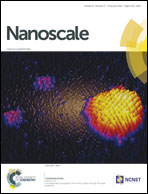What is below the support layer affects carbon nanotube growth: an iron catalyst reservoir yields taller nanotube carpets†
Abstract
Here we demonstrate an approach to enhance the growth of vertically aligned carbon nanotubes (CNTs) by including a catalyst reservoir underneath the thin-film alumina catalyst underlayer. This reservoir led to enhanced CNT growth due to the migration of catalytic material from below the underlayer up to the surface through alumina pinholes during processing. This led to the formation of large Fe particles, which in turn influenced the morphology evolution of the catalytic iron surface layer through Ostwald ripening. With inclusion of this catalyst reservoir, we observed CNT growth up to 100% taller than that observed without the catalyst reservoir consistently across a wide range of annealing and growth durations. Imaging studies of catalyst layers both for different annealing times and for different alumina support layer thicknesses demonstrate that the surface exposure of metal from the reservoir leads to an active population of smaller catalyst particles upon annealing as opposed to a bimodal catalyst size distribution that appears without inclusion of a reservoir. Overall, the mechanism for growth enhancement we present here demonstrates a new route to engineering efficient catalyst structures to overcome the limitations of CNT growth processes.


 Please wait while we load your content...
Please wait while we load your content...